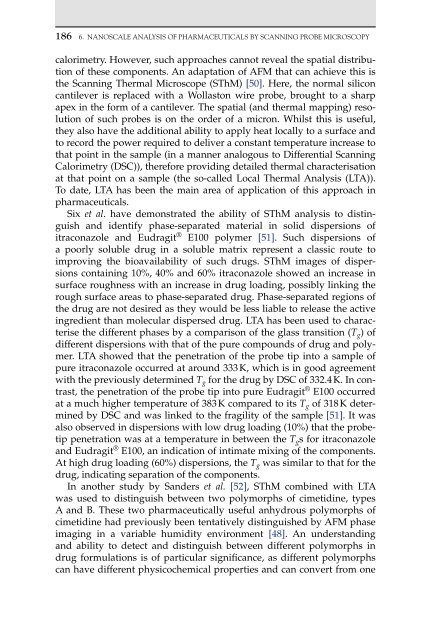W. Richard Bowen and Nidal Hilal 4
W. Richard Bowen and Nidal Hilal 4
W. Richard Bowen and Nidal Hilal 4
- No tags were found...
Create successful ePaper yourself
Turn your PDF publications into a flip-book with our unique Google optimized e-Paper software.
186 6. NANOSCALE ANALySIS Of PHARMACEUTICALS by SCANNINg PRObE MICROSCOPy<br />
calorimetry. However, such approaches cannot reveal the spatial distribution<br />
of these components. An adaptation of AFM that can achieve this is<br />
the Scanning Thermal Microscope (SThM) [50]. Here, the normal silicon<br />
cantilever is replaced with a Wollaston wire probe, brought to a sharp<br />
apex in the form of a cantilever. The spatial (<strong>and</strong> thermal mapping) resolution<br />
of such probes is on the order of a micron. Whilst this is useful,<br />
they also have the additional ability to apply heat locally to a surface <strong>and</strong><br />
to record the power required to deliver a constant temperature increase to<br />
that point in the sample (in a manner analogous to Differential Scanning<br />
Calorimetry (DSC)), therefore providing detailed thermal characterisation<br />
at that point on a sample (the so-called Local Thermal Analysis (LTA)).<br />
To date, LTA has been the main area of application of this approach in<br />
pharmaceuticals.<br />
Six et al. have demonstrated the ability of SThM analysis to distinguish<br />
<strong>and</strong> identify phase-separated material in solid dispersions of<br />
itraconazole <strong>and</strong> Eudragit ® E100 polymer [51]. Such dispersions of<br />
a poorly soluble drug in a soluble matrix represent a classic route to<br />
improving the bioavailability of such drugs. SThM images of dispersions<br />
containing 10%, 40% <strong>and</strong> 60% itraconazole showed an increase in<br />
surface roughness with an increase in drug loading, possibly linking the<br />
rough surface areas to phase-separated drug. Phase-separated regions of<br />
the drug are not desired as they would be less liable to release the active<br />
ingredient than molecular dispersed drug. LTA has been used to characterise<br />
the different phases by a comparison of the glass transition (T g) of<br />
different dispersions with that of the pure compounds of drug <strong>and</strong> polymer.<br />
LTA showed that the penetration of the probe tip into a sample of<br />
pure itraconazole occurred at around 333 K, which is in good agreement<br />
with the previously determined T g for the drug by DSC of 332.4 K. In contrast,<br />
the penetration of the probe tip into pure Eudragit ® E100 occurred<br />
at a much higher temperature of 383 K compared to its T g of 318 K determined<br />
by DSC <strong>and</strong> was linked to the fragility of the sample [51]. It was<br />
also observed in dispersions with low drug loading (10%) that the probetip<br />
penetration was at a temperature in between the T gs for itraconazole<br />
<strong>and</strong> Eudragit ® E100, an indication of intimate mixing of the components.<br />
At high drug loading (60%) dispersions, the T g was similar to that for the<br />
drug, indicating separation of the components.<br />
In another study by S<strong>and</strong>ers et al. [52], SThM combined with LTA<br />
was used to distinguish between two polymorphs of cimetidine, types<br />
A <strong>and</strong> B. These two pharmaceutically useful anhydrous polymorphs of<br />
cimetidine had previously been tentatively distinguished by AFM phase<br />
imaging in a variable humidity environment [48]. An underst<strong>and</strong>ing<br />
<strong>and</strong> ability to detect <strong>and</strong> distinguish between different polymorphs in<br />
drug formulations is of particular significance, as different polymorphs<br />
can have different physicochemical properties <strong>and</strong> can convert from one
















